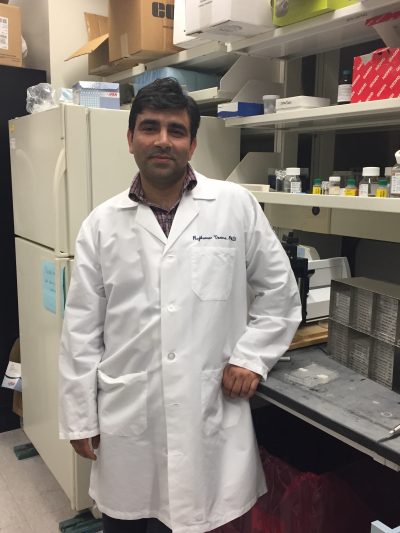As we near the end of heart disease and stroke awareness month, Biomedical Sciences Ph.D. candidate Brittany Knight offers some insights into the exciting developments in stroke research at UConn Health. She met with Rajkumar Verma, Ph.D., an assistant professor in the Department of Neuroscience at the Pat and Jim Calhoun Cardiology Center to discuss a recent conference he attended and his research studying potential therapeutic targets for protecting the brain following stroke.
To understand the exciting new discoveries in stroke research, we first need to know what stroke is and what happens to the body following stroke. Stroke is an incidental disease that affects the entire body (systemic disorder) when blood supply is prevented from reaching the brain. Lack of blood supply decreases the amount of oxygen and nutrients required to keep brain cells healthy and functioning properly. Other areas of the body beyond the brain are also affected by stroke, for instance pneumonia and urinary tract infections are the most common complications following stroke. Recently, the effect of stroke on gut microbiota axis has drawn serious attention. The microbes that inhabit your gastrointestinal system can transport toxic substances and exacerbate the inflammatory response following stroke. When a stroke occurs or if you see someone having a stroke you may notice some odd things that occur as a result of this blood/oxygen loss. These symptoms are important to know and are easily remembered by memorizing the acronym F.A.S.T. – Facial drooping; Arm weakness; Speech difficulties; and Time. If you notice any of these symptoms in another person or yourself – call 911!

Within the first 5 minutes of discontinued blood supply, brain cells start to die. This rapid cell death results in inflammation and increases the risk of additional brain damage in surrounding regions. Damage increases progressively in the absence of reestablished blood flow or drug treatment. Currently, tPA (tissue plasminogen activator) and thrombectomy, the removal of a blood clot, are the only FDA-approved available treatment for stroke. TPA treatment works by breaking down blood clots and is beneficial if administered within a narrow 4-5 hours following a stroke, similar to thrombectomy. This time frame emphasizes the importance of T in the F.A.S.T. acronym. However, sometimes individuals that have a stroke do not seek immediate medical attention and wait until the following day to see their physician or go to the emergency room. This unfortunately can result in more brain damage and impede the recovery process.
However, exciting new developments in the field of stroke research show new promise for individuals who do not receive immediate treatment. This January, Dr. Verma attended the world’s largest conference for cerebrovascular disease: the 2018 International Stroke Conference in Los Angeles. More than 4,500 individuals in the field of stroke and some 1,500 presentations were given on the pathophysiology and potential treatments for cerebrovascular diseases, including stroke. Attendees consisted of researchers, clinicians, nurses, and therapists as well as other professionals from around the world. During the International Stroke Conference, it was revealed that the time that thrombectomy is beneficial is now extended to 16-24 hours following a stroke in an eligible patient. Time is still important, but this means surgical intervention can be administered later thus, more people can receive medical attention.
In the clinic, doctors seek to reach several goals: increase the amount of oxygen and nutrients to the brain to preserve tissue that may become damaged during the inflammatory process as well as rehabilitate patients post-stroke to improve and maintain both physical and mental health. The conference also discussed that starting rehabilitation more than 2 months and even as late as 6 months following a stroke can still provide benefit to the recovery process. In other words, if you or someone you know suffered from a stroke in the last 6 months and has not been physically active, the benefits of starting physical therapy are still warranted.
The National Institute of Health funds a variety of research aimed at providing more effective therapies for stroke. One method thought to help decrease the amount of damage that occurs following stroke, during the inflammatory process, is by decreasing core body temperature. Researchers have shown that during hibernation, reptiles (as well as other animals) can decrease their core body temperature which slows cellular metabolism. Essentially, this method slows down the speed of reactions inside the body to protect the brain from additional damage post-stroke.
Similarly, Dr. Verma is interested in finding a candidate target that can be pharmacologically inhibited following stroke to decrease brain damage. Excessive ATP release, which occurs during mass cell death or when oxygen is cut off from part of the brain, can increase the activity of brain cells and the release of inflammatory mediators causing further damage. He has found a candidate, called P2X purinoceptor 4 (P2X4). P2X4 binds ATP which is released by stressed or dying cells and leads to the inflammatory process. This vicious cycle of cell death and inflammation can cause significant detriments to physical and mental function if untreated. By targeting P2X4, Dr. Verma hopes to disrupt this pathway and potentially improve outcomes following stroke.